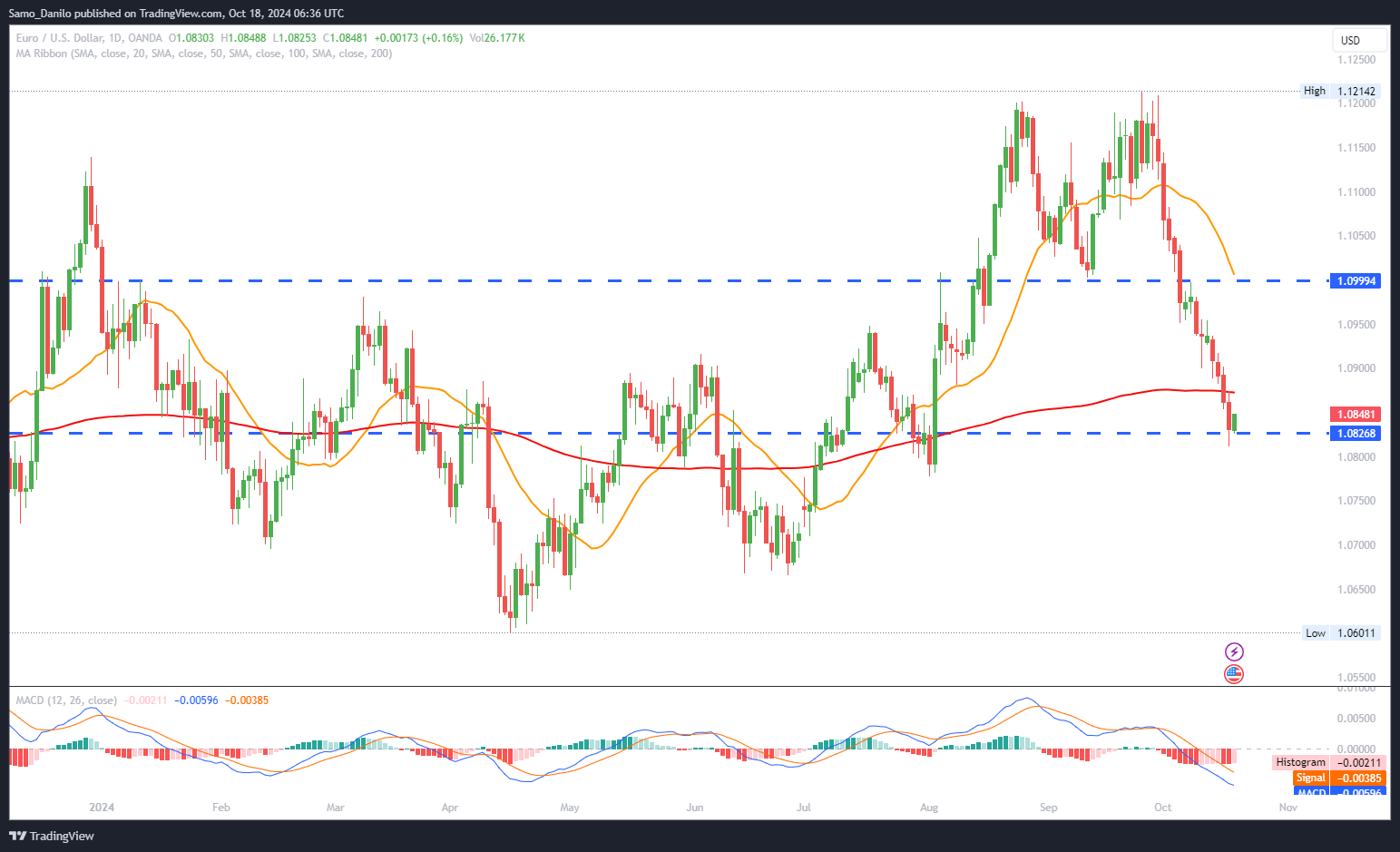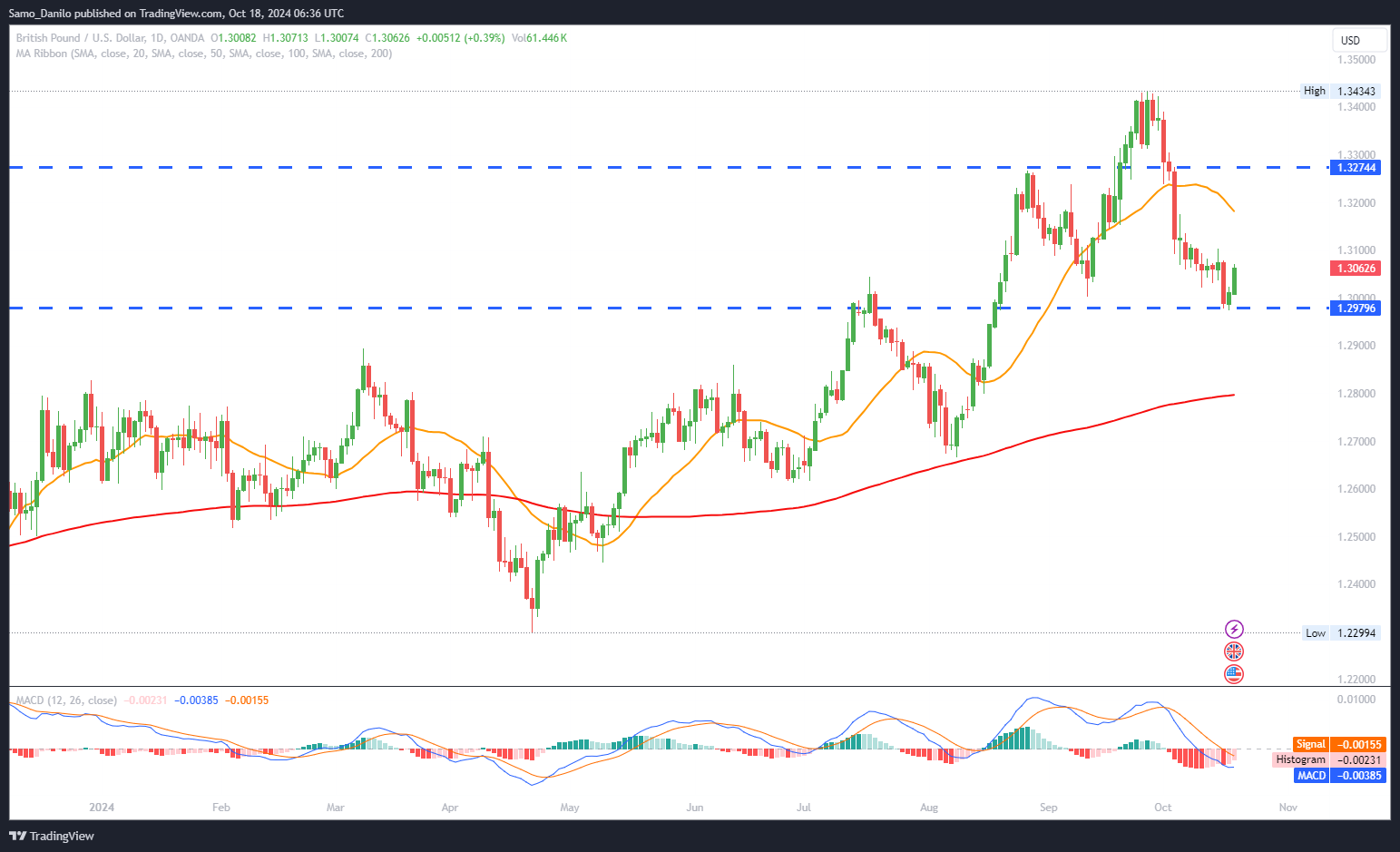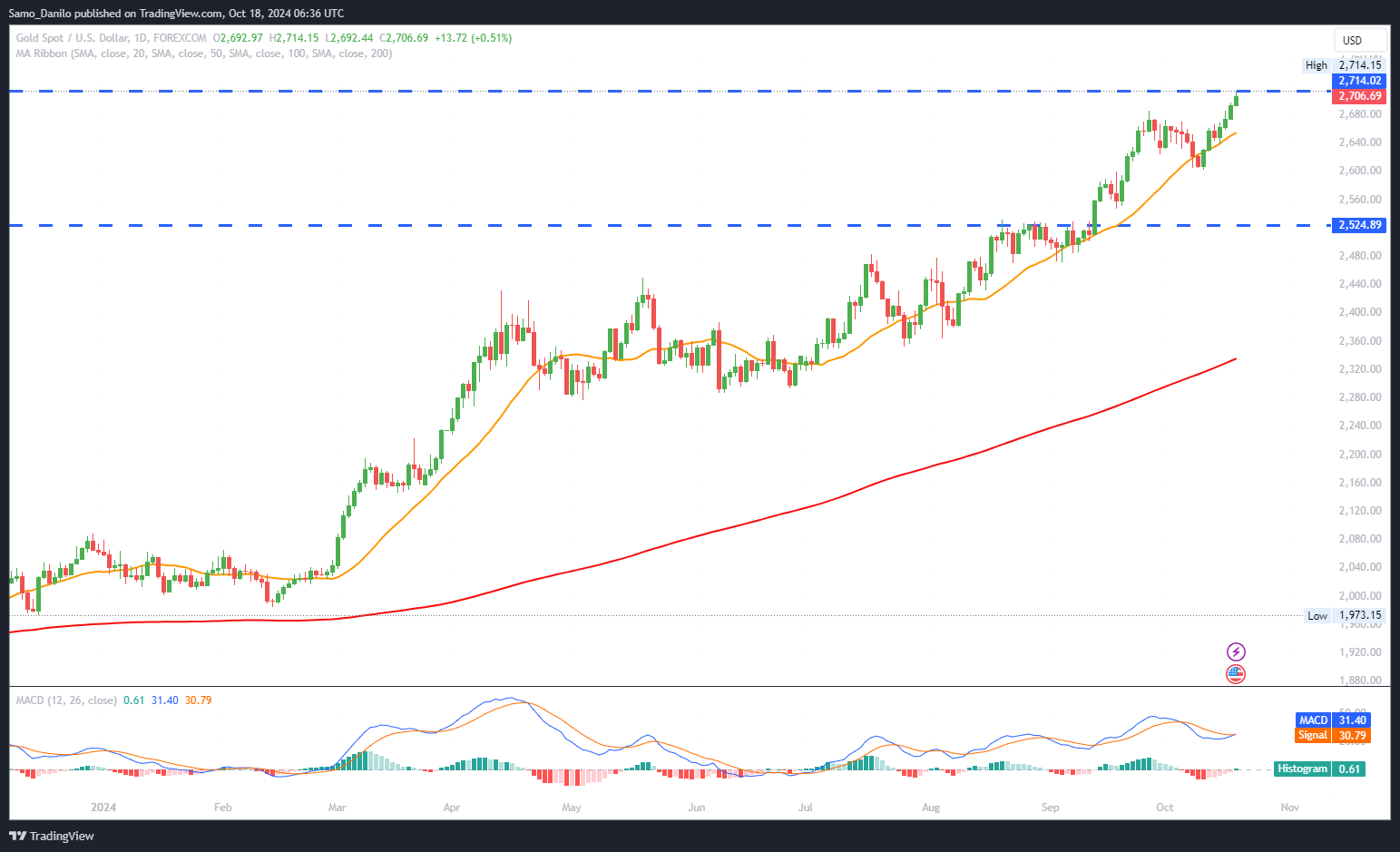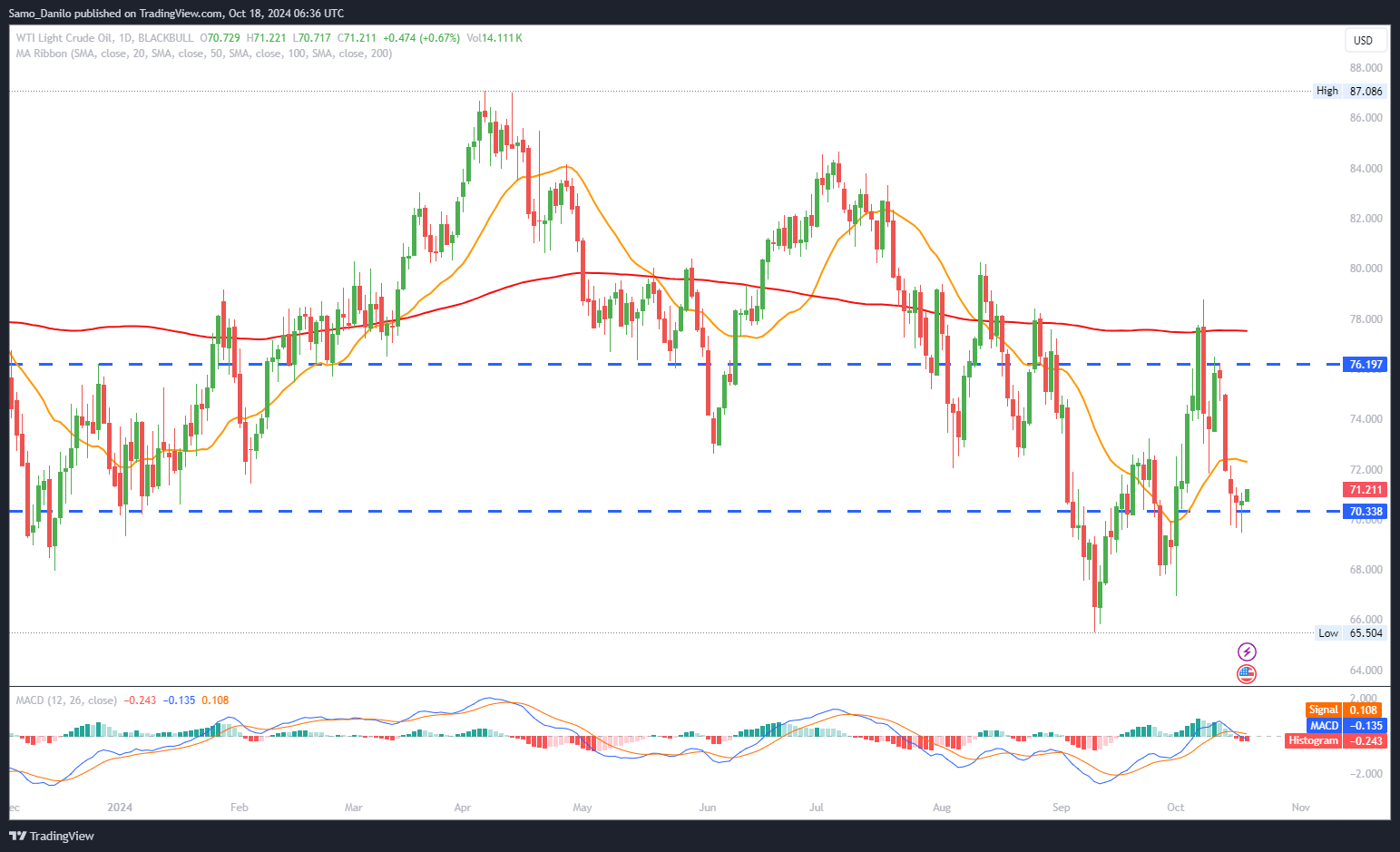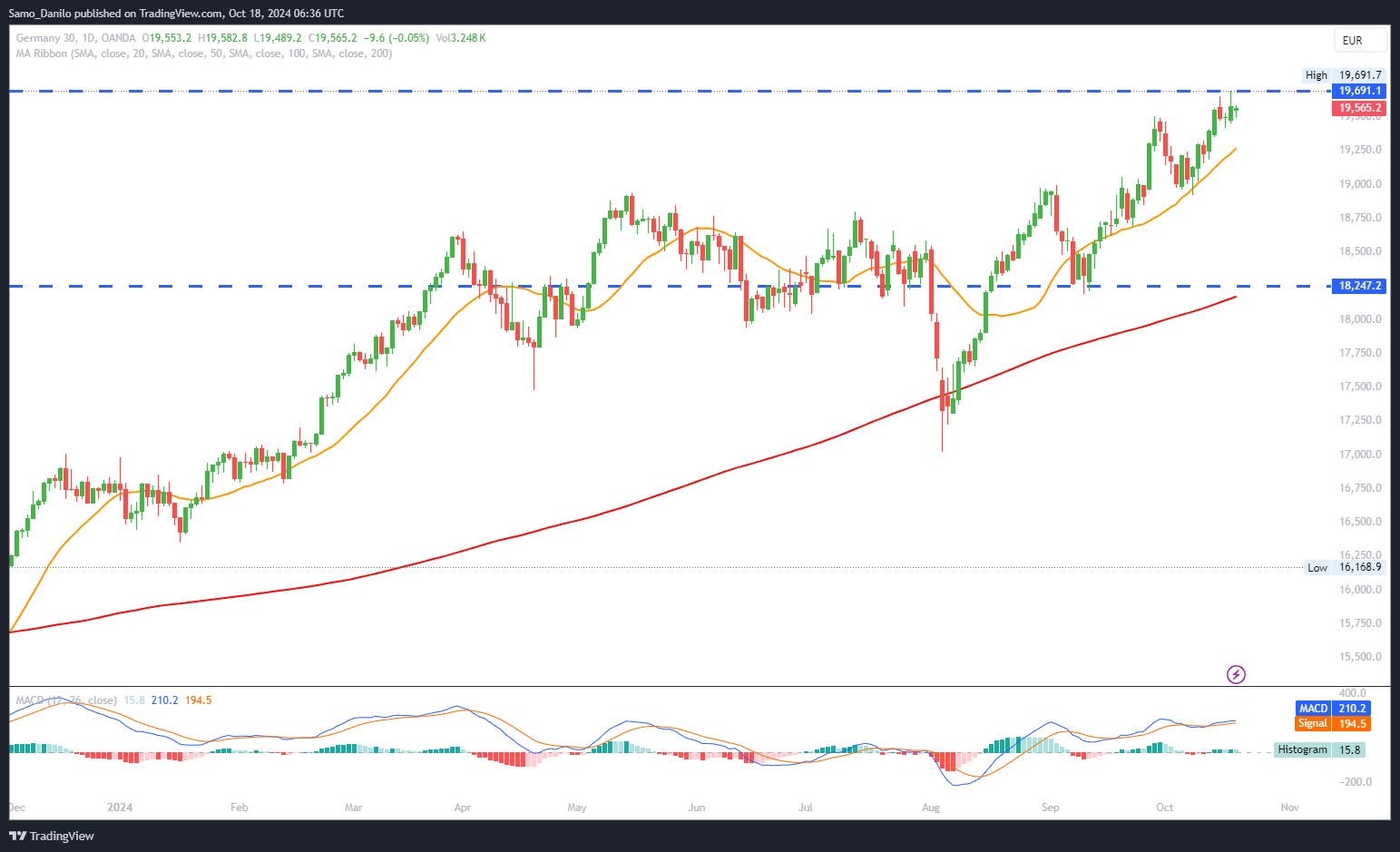EURUSD
- EUR/USD Price: The EUR/USD pair halted its four-day decline, trading around 1.0840 during the European session on Friday. This recovery came after a series of downward pressures on the Euro, signalling a potential stabilization for the currency.
- US Dollar: The US Dollar reached a two-month high of 103.87 on Thursday, driven by solid US Retail Sales data. This report fuelled expectations that the Federal Reserve may proceed with nominal interest rate cuts. Strong retail sales reflect consumer resilience, which has bolstered the Greenback and pressured the EUR/USD pair.
- ECB Rate Cut: The European Central Bank (ECB) followed expectations and reduced its policy rates by 25 basis points, lowering the Deposit Facility Rate to 3.25%. This move highlights the ECB's focus on addressing weak economic growth and controlling inflation.
- Lagarde's Economic Outlook: ECB President Christine Lagarde pointed to weaker- than-expected economic activity in the Eurozone, highlighting sluggish growth and a slow recovery in household spending. Lagarde also warned of downside growth risks, which may keep the ECB leaning towards more dovish policy measures.
- Eurozone Inflation: Eurozone inflation, as measured by the Harmonized Index of Consumer Prices (HICP), dropped to 1.7% in September, falling below the ECB’s 2% target. Coupled with stagnating GDP growth, these factors have strengthened the case for additional ECB rate cuts in the coming months, as the central bank grapples with low inflation and slow economic momentum.
Closing statement: The EUR/USD pair has managed to rebound after a four-day losing streak, buoyed by a temporary slowdown in US Dollar gains. The Federal Reserve's solid US Retail Sales data has propped up the USD, while the ECB's 25-basis point rate cut reflects ongoing concerns about the Eurozone's weak economic performance and inflation below target. Looking ahead, the possibility of further ECB rate cuts and US economic strength will likely continue to drive volatility in the EUR/USD pair.
GBPUSD
- GBP/USD Price: The GBP/USD pair recovers from its two-month low, trading near 1.3025 early Friday. This recovery is supported by profit-taking from US Dollar buyers, which has provided a temporary lift to the British Pound after a series of declines.
- UK Retail Sales: Retail sales in the UK rose by 0.3% in September, following a stronger 1.0% increase in August, according to the latest data from the Office for National Statistics (ONS). This moderate growth in retail activity helped stabilize the GBP after a recent selloff driven by weak inflation data.
- UK Inflation: Wednesday’s softer-than-expected inflation readings from the UK led investors to start pricing in multiple rate cuts by the Bank of England (BoE) this year. This shift in expectations caused a significant decline in the British Pound, reflecting concerns about a more dovish monetary policy outlook.
- US Housing Market Data: Traders are now awaiting the release of US housing market data, including Building Permits and Housing Starts, during the early North American session. The performance of the US housing sector could influence the US Dollar (USD) and create new short-term trading opportunities for the GBP/USD pair.
- Waller’s Speech: Fed Governor Christopher Waller's upcoming speech will be closely monitored for insights into the Federal Reserve’s interest rate policy. His comments could further impact the USD and the overall trajectory of the GBP/USD pair, which is on track to post losses for the third consecutive week.
| SMA (20) | Slightly Falling |
| |
| RSI (14) | Falling |
|
|
| MACD (12, 26, 9) | Falling |
|
|
Closing statement: GBP/USD has recovered slightly from a two-month low, supported by profit-taking in the US Dollar and a modest rise in UK retail sales. However, the pair remains under pressure due to expectations of multiple BoE rate cuts following softer UK inflation data. US housing market data and a speech from Fed Governor Waller will be key drivers for short-term price action in the pair, which remains on course for its third straight week of losses.
GOLD
- Gold’s ATH: Gold prices surged to a new all-time high, trading above $2,700 on Friday and reaching a peak at around $2,714. This record level highlights the ongoing demand for safe-haven assets amidst market uncertainties.
- USD Retreats: The US Dollar, which had recently reached over two-month highs against a basket of major currencies, pulled back in Asian trading on Friday. This retreat comes as USD buyers paused to take profits after the Greenback’s rally, which was partly driven by market optimism about Donald Trump’s prospects in the 2024 US presidential election.
- Geopolitical Tensions: The escalation of geopolitical tensions in the Middle East, particularly between Iran and Israel, has fueled fresh demand for Gold as a safe-haven asset. Reports that Hezbollah, an Iran-backed militant group, plans to escalate conflict with Israel after the killing of a Hamas leader have further increased market uncertainty and demand for gold.
- Fed Rate Cut Expectations: A 25 basis points (bps) rate cut by the US Federal Reserve (Fed) in November appears to be a foregone conclusion. This certainty has tempered the potential impact of upcoming US economic data, including Retail Sales figures, on market sentiment and gold price movements.
- Focus on News: Investors are now closely watching further developments in the Middle East, which could continue to influence gold prices. Additionally, remarks from Federal Reserve policymakers will be monitored for clues on the future direction of US interest rates, which could also provide further impetus for gold trading.
| SMA (20) | Rising |
|
|
| RSI (14) | Rising |
|
|
| MACD (12, 26, 9) | Slightly Rising |
|
Closing statement: Gold prices have reached record highs, supported by geopolitical tensions, a temporary retreat in the US Dollar, and renewed optimism around Chinese economic stimulus. As global risks rise, investors are flocking to Gold as a safe-haven asset, with a close watch on Middle Eastern geopolitics and Fedspeak for potential impacts on future price movements.
CRUDE OIL
- WTI Oil Prices: West Texas Intermediate (WTI) crude oil prices continued their upward trend for a second consecutive day, trading around $70.50 per barrel during European trading hours on Friday. This rise comes after recent price fluctuations amid various global factors.
- US Crude Oil Stock: The Energy Information Administration (EIA) reported a 2.192 million barrel decrease in US crude oil stockpiles for the week ending October 11. This drawdown was unexpected, as the market had predicted a 2.3 million barrel increase, contrasting sharply with the previous week’s 5.81 million barrel rise. This decline in oil stocks has provided some support for oil prices.
- Middle East Tensions: Escalating tensions in the Middle East, particularly following Israel's confirmation of the death of Yahya Sinwar, a key leader of Hamas, have added to the upward pressure on oil prices. This geopolitical risk has heightened concerns about potential supply disruptions in the region, pushing oil demand higher as a precautionary measure.
- US Production: Despite the recent gains in oil prices, the potential for further upward movement may be limited. The EIA report also showed that US crude oil production reached a record high of 13.5 million barrels per day last week. Increased supply levels could counterbalance some of the upward pressure from geopolitical tensions.
- IEA Prediction: On Tuesday, the International Energy Agency (IEA) signaled that the global oil market is likely heading for a significant surplus in the coming year. This projection suggests that the current bullish trend may not last long, as higher production levels and slowing demand could eventually weigh on prices.
| SMA (20) | Slightly Rising |
|
| RSI (14) | Slightly Falling |
|
| MACD (12, 26, 9) | Slightly Falling |
|
Closing statement: WTI crude oil prices are seeing support from a combination of lower-than-expected US oil inventories and rising geopolitical tensions in the Middle East. However, record-high US production and a forecasted surplus in the global oil market may limit the long-term upside potential for oil prices. Traders will likely remain focused on geopolitical developments and production data in the near term.
DAX
- DAX’s ATH: On Thursday, the DAX index advanced by 0.77%, recovering from the previous day's 0.27% loss. The index hit a new all-time high, trading around 19,675 during the session. This rally was fueled by strong earnings and positive momentum in specific sectors.
- Company-Specific Gains: Several companies listed on the DAX saw notable gains on Thursday. Sartorius AG led the pack, surging by 16.45%, driven by better-than- expected order intake figures. Merck also had a strong performance, rallying 7.56% on the back of favorable market conditions and corporate news.
- Eurozone Inflation and ECB Rate Cut: Inflation data released on Thursday indicated that the Eurozone's annual inflation rate fell to 1.7% in September from 2.2% in August. This decline raised expectations for multiple rate cuts from the European Central Bank (ECB). In response to the softening inflation and economic concerns, the ECB delivered a 25-basis-point rate cut on Thursday, in line with market forecasts.
- December Rate Cut Speculation: The combination of lower inflation and a weakening macroeconomic outlook has led to speculation that the ECB may implement another rate cut in December. Investors are closely watching the ECB’s policy direction as it responds to these evolving conditions.
- US Retail Sales: In the US, retail sales data showed a 0.5% increase in September, following a modest 0.1% rise in August. This robust consumer spending trend has raised concerns that demand-driven inflation may persist, potentially delaying any post-November interest rate cuts by the Federal Reserve (Fed).
| SMA (20) | Rising |
|
|
| RSI (14) | Rising |
|
|
| MACD (12, 26, 9) | Rising |
|
|
Closing statement: The DAX’s strong performance on Thursday, reaching a new all-time high, was driven by significant corporate gains and broader market optimism. Eurozone inflation data and the ECB’s 25-basis-point rate cut have fuelled expectations of further easing, which could support the DAX in the coming months. However, strong US retail sales data suggest that inflationary pressures may persist, potentially influencing global monetary policy decisions.
